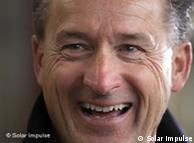AVIATION | 13.05.2011
Swiss pilot undertakes first international solar-powered flight
On Friday morning, the Swiss pilot and entrepeneur André Borschberg took off on his first international flight of his solar-powered plane, the Solar Impulse. He departed from an airbase in Payerne, Switzerland, in the country's northwest near the French border, and headed for Brussels, Belgium. The flight is scheduled to take 12 hours, which is far less than the previous flight record of 26 hours that Borschberg completed last year. The Swiss pilot hopes that proving that solar-powered aircraft are viable will usher in a new generation of greener air travel. Deutsche Welle spoke with him by phone early on Friday morning while he was piloting the Solar Impulse.
Deutsche Welle: You've started your first test flight with the airplane [early] this morning. How is it going?
André Borschberg: It's going extremely well. We had a little bit of a hectic time in the beginning because we had to take off before a formation of military air planes. We were not totally ready to accelerate so we did part of our work in-flight but everything is now back to order. And the weather is just gorgeous.
What kind of weather conditions did you need to start this flight?
Of course we need to have the airplane in the sun. You also have to remember that it is a prototype airplane, it is not the airplane with which we will travel around the world so we have more limitations. But we also need reasonable wind on the ground, we need good weather overall. Funnily, we had big thunderstorms here yesterday, we will have thunderstorms tomorrow morning but today we have a very nice wind to reach Brussels.
 André Borschberg is piloting the Solar Impulse from Switzerland to BelgiumIn the future you will also fly during the night which means that your batteries need to be charged during the day. Do you produce enough energy right now? Do you produce more energy than you will eventually need?
André Borschberg is piloting the Solar Impulse from Switzerland to BelgiumIn the future you will also fly during the night which means that your batteries need to be charged during the day. Do you produce enough energy right now? Do you produce more energy than you will eventually need?Yes, much more. The batteries are almost full but unfortunately we will not be able to use the energy I collect. If I had more batteries I could leave this energy pack on the ground when we land because we will be very energy positive today. Not only will we not need any fuel but we could also produce much more energy, so that's really fascinating.
Your next big flight is going to be 36 hours long. How much more preparations do you need to do that?
The first night flight [we completed] last year. Last year in July we did a flight of 26 hours so that was a full day and a full night. We demonstrated that with this airplane you can fly day and night for many days and many nights. Next year we are planning effectively to do longer flights, maybe two days and two nights. That will be the demonstration that the airplane really uses very little energy. We would like to show that the technology we have on this airplane is very efficient and can also be used on the ground on any applications there.
And when do you think you will be able to fly around the world?
We are building a second airplane. We are starting with the construction in two months and the airplane should be ready in two years. We plan to do the big flights, the ocean crossings and the flight around the world from 2014. We just train, that's also what we are doing today, not only for the pilots but we have a big team on the ground and everybody has to learn how to avoid such a painful long distance flight.
 The Solar Impulse's longest flight was 26 hoursA lot of research went into this project. Do you think it will also help revolutionize air travel for low emission aircraft in the future?
The Solar Impulse's longest flight was 26 hoursA lot of research went into this project. Do you think it will also help revolutionize air travel for low emission aircraft in the future?Of course, but it will take a lot of time. We have to remember that when the Wright brothers did their first flight in 1903 it took 25 more years for Charles Lindbergh to cross the Atlantic alone and it took another 25 years for people to cross the Atlantic on transport airplanes so we are looking at the same time frame here. IATA, which is the International Air Transport Association, has set a goal for a huge carbon emission reduction by 50 percent in 2050 so that's what we are looking for and looking at. But, we need to start at the beginning.
Today is Friday the 13th. Did you have any thoughts about it in terms of superstition?
Yes of course! But I like these days because I was born on the 13th of December so for me that was a very favorable sign.
Interview: Fabian Schmidt
Editor: Cyrus Farivar
Editor: Cyrus Farivar
DW


No comments:
Post a Comment